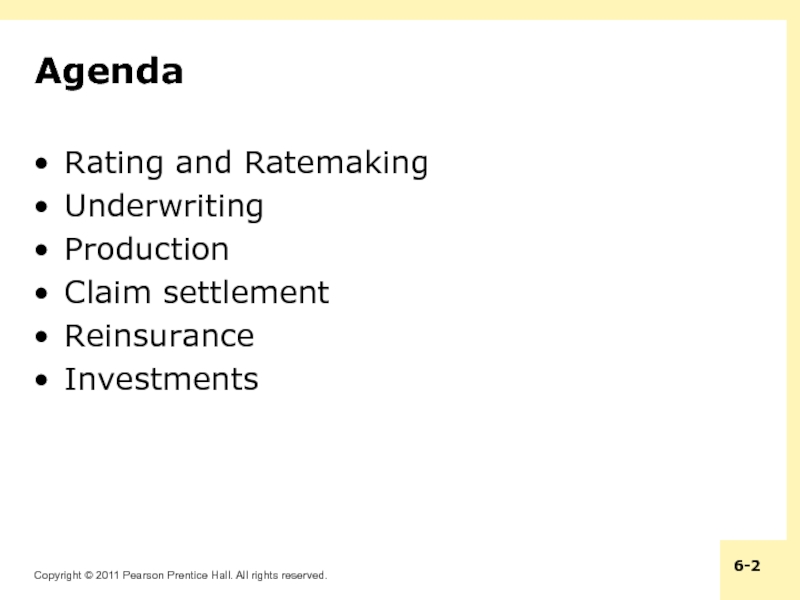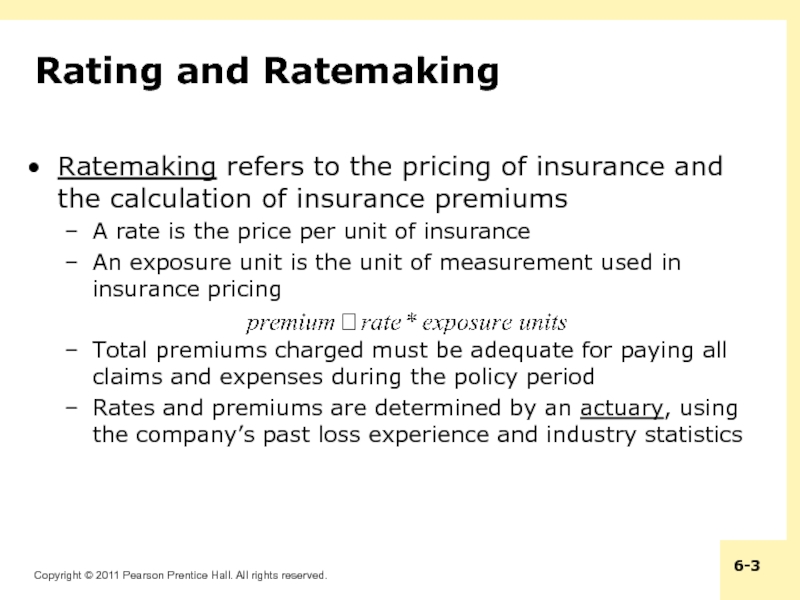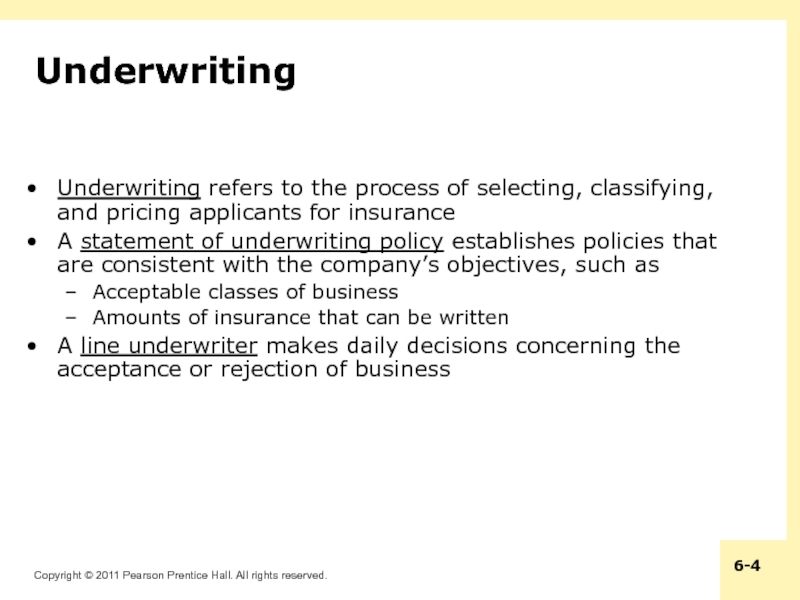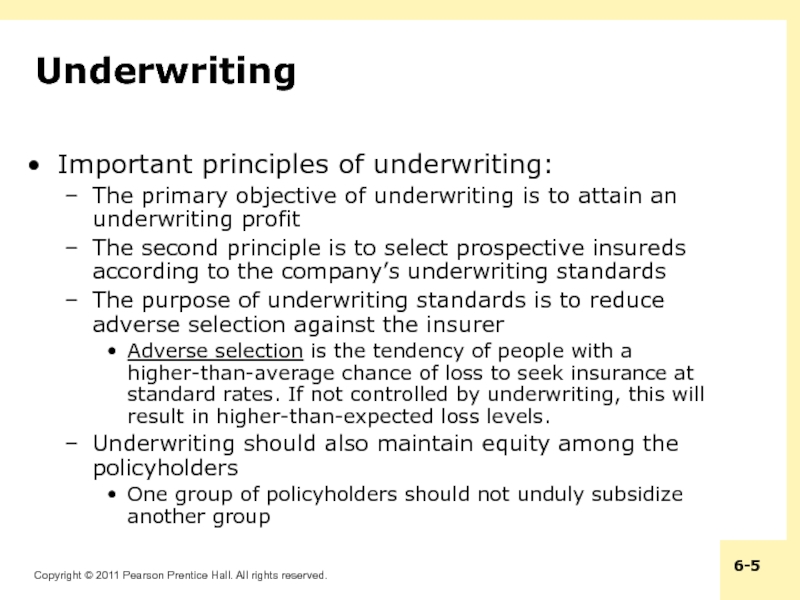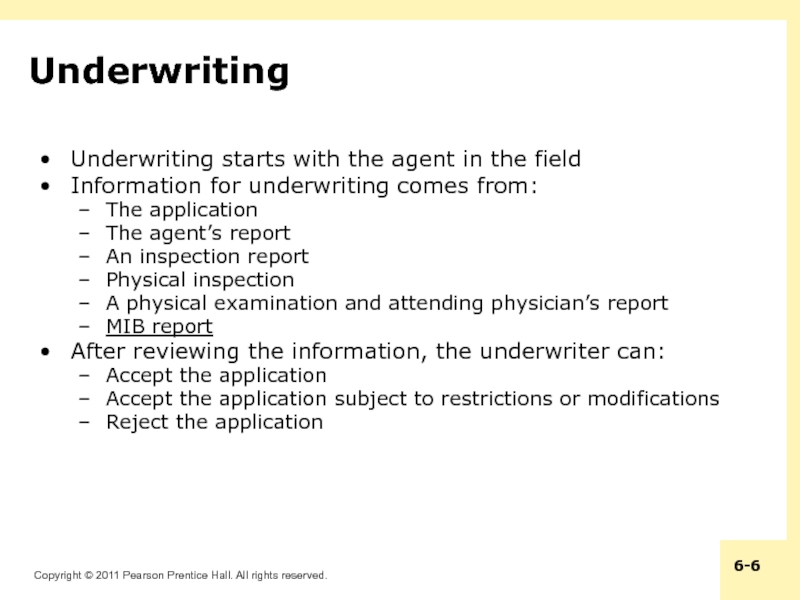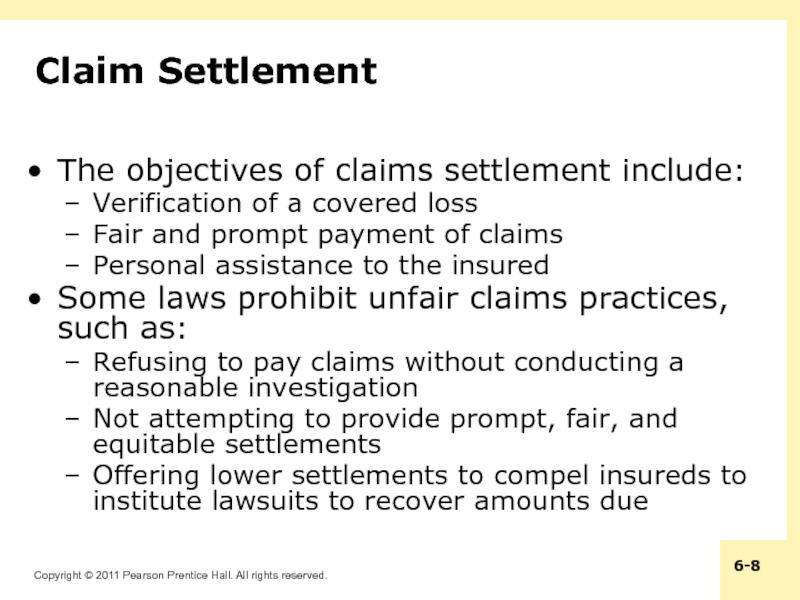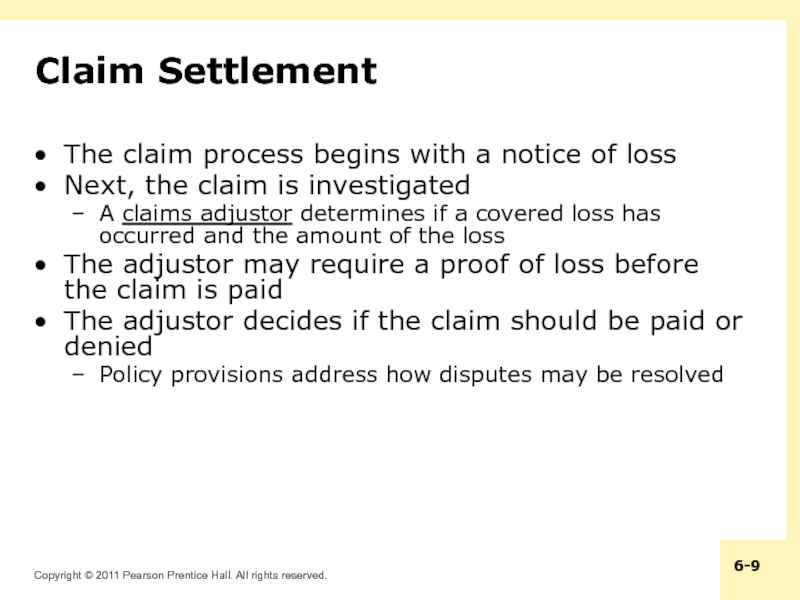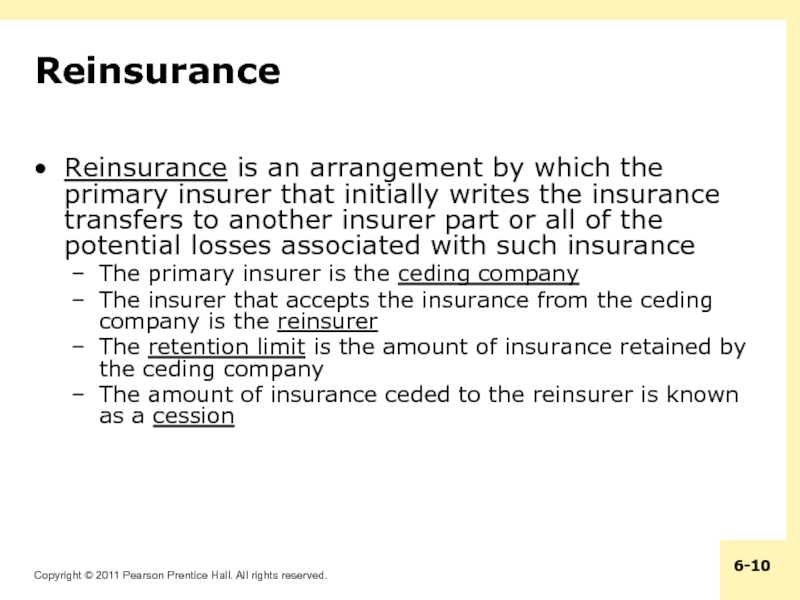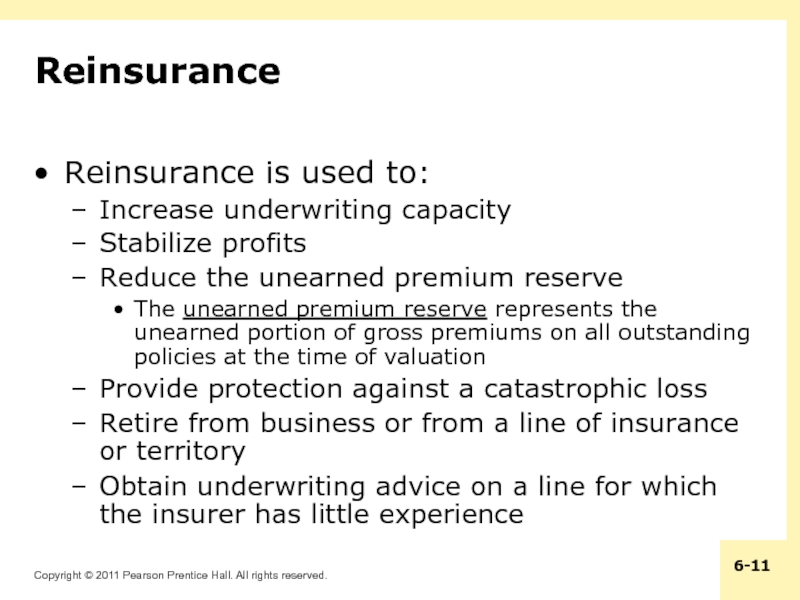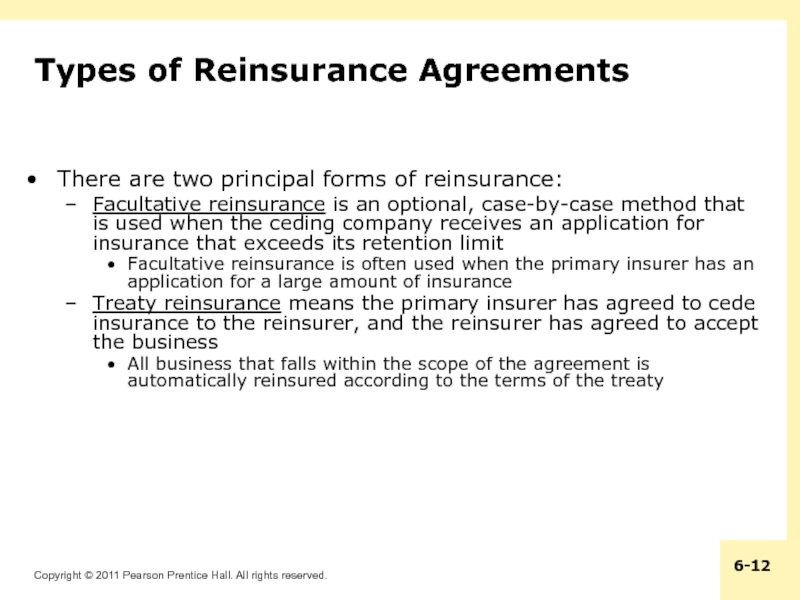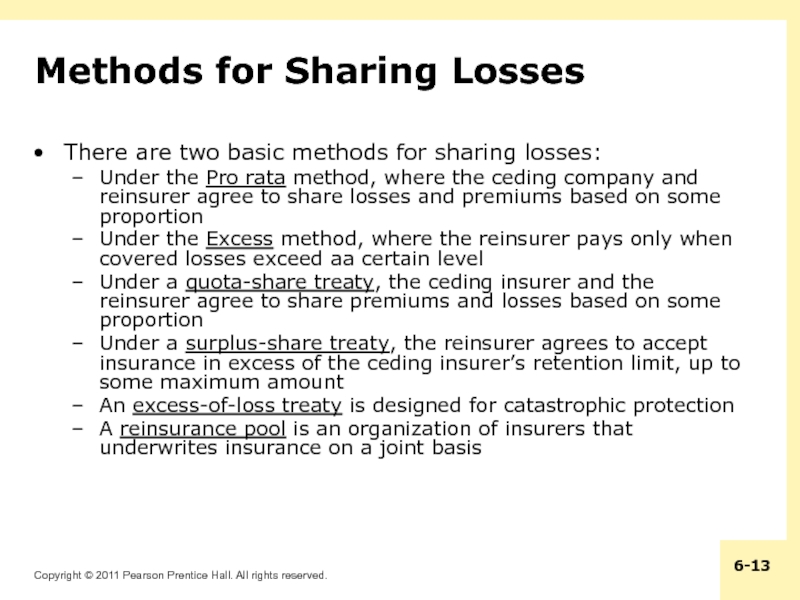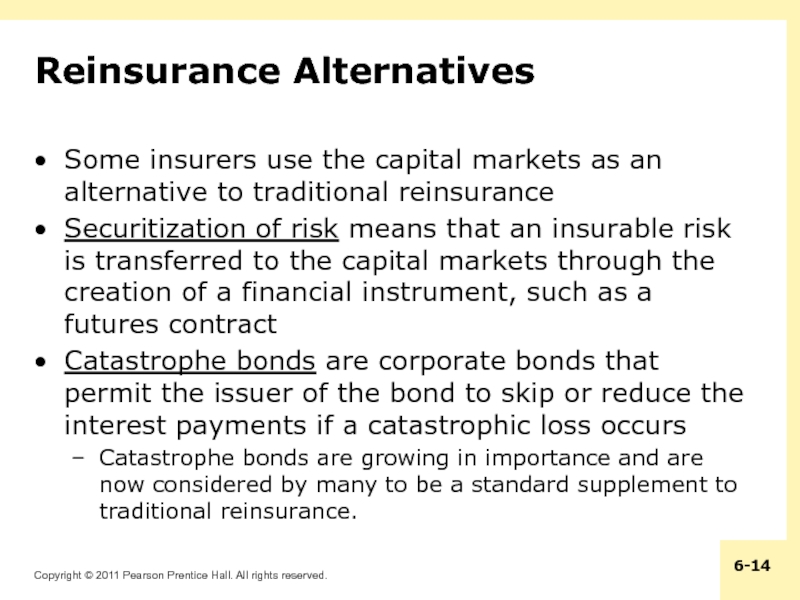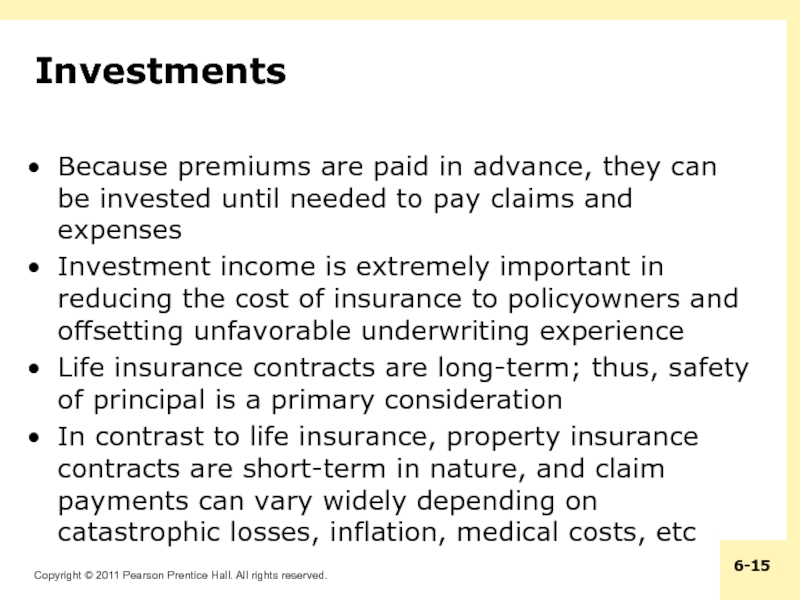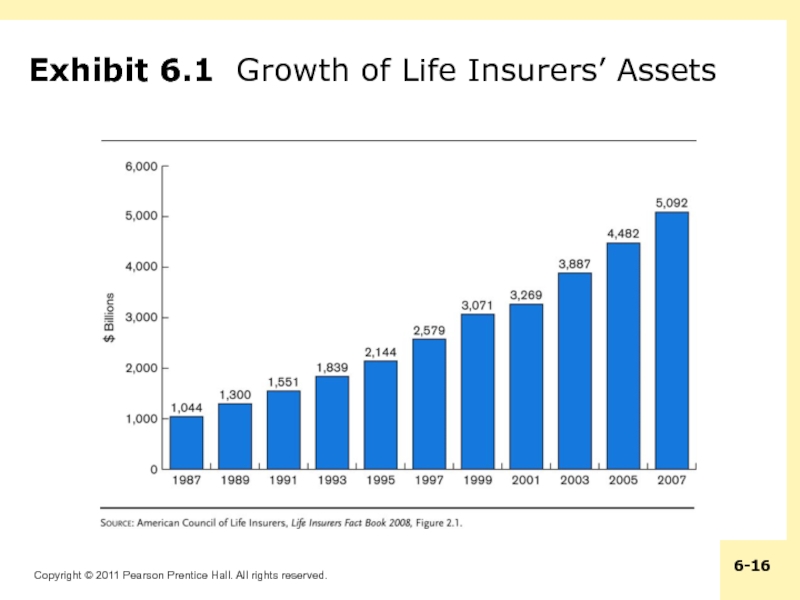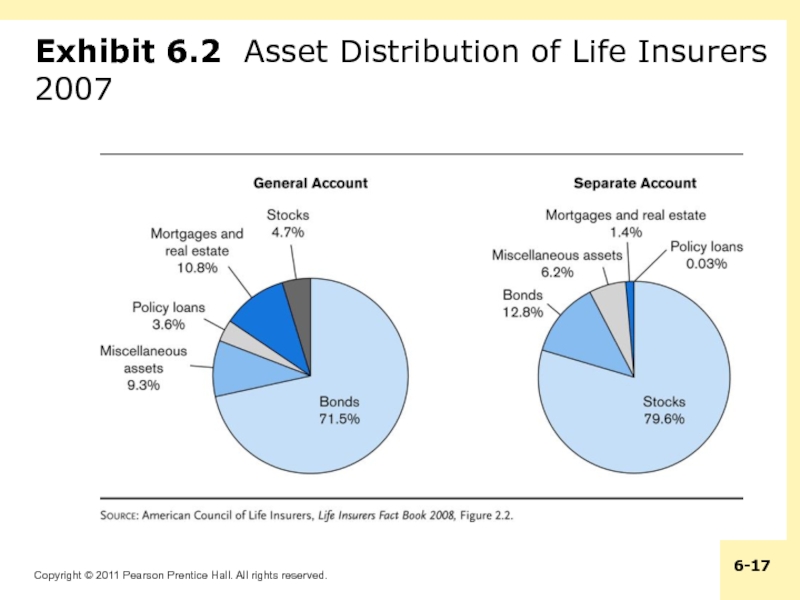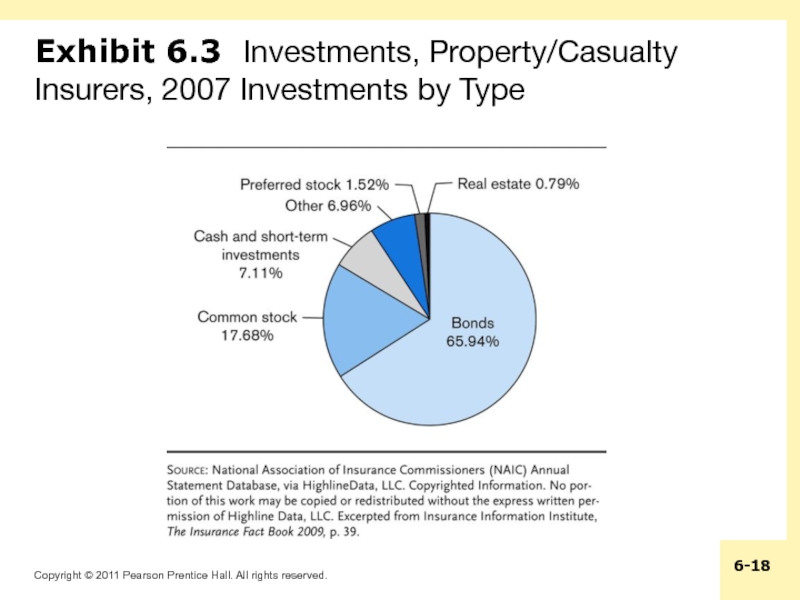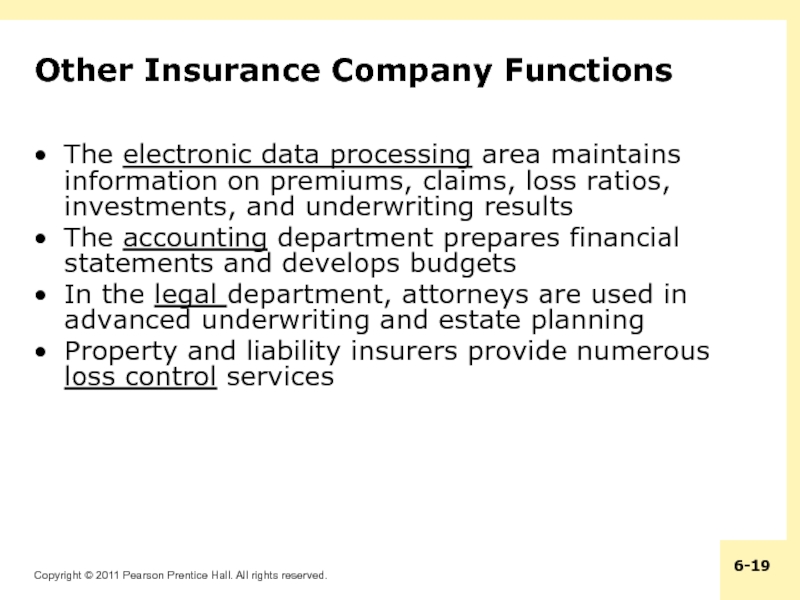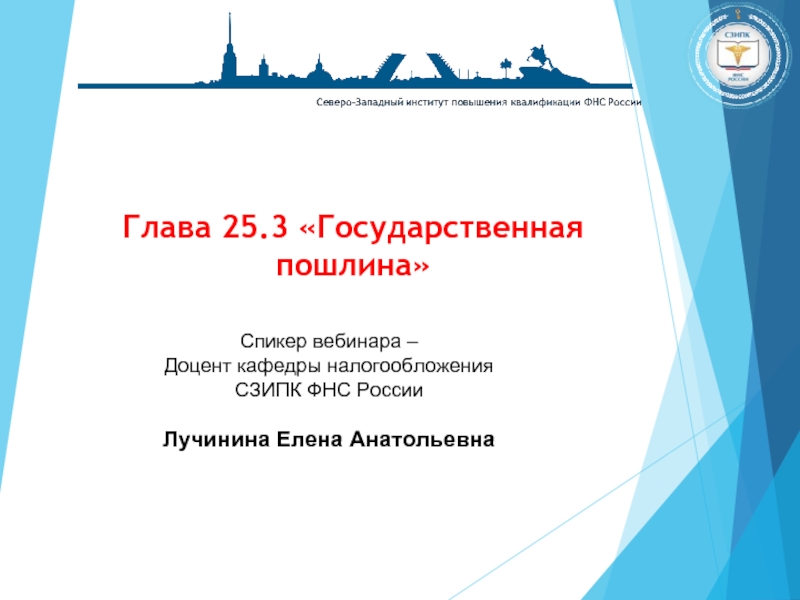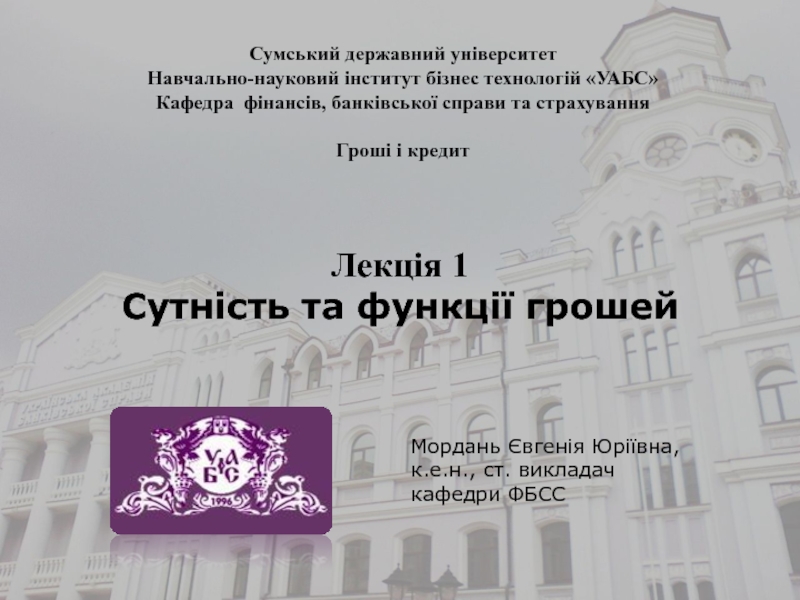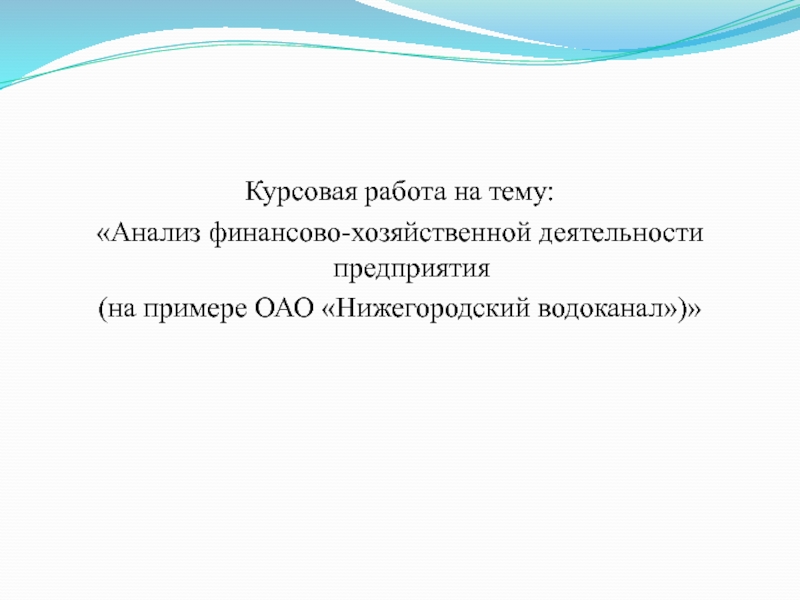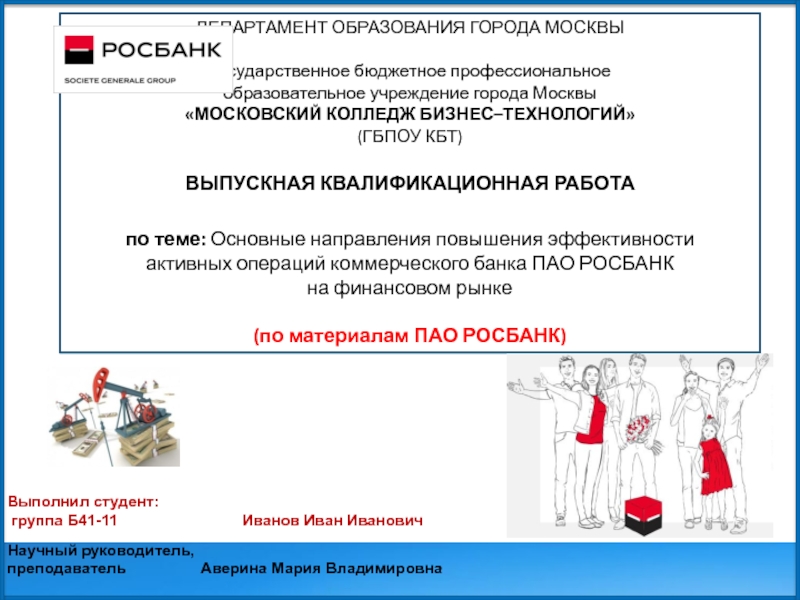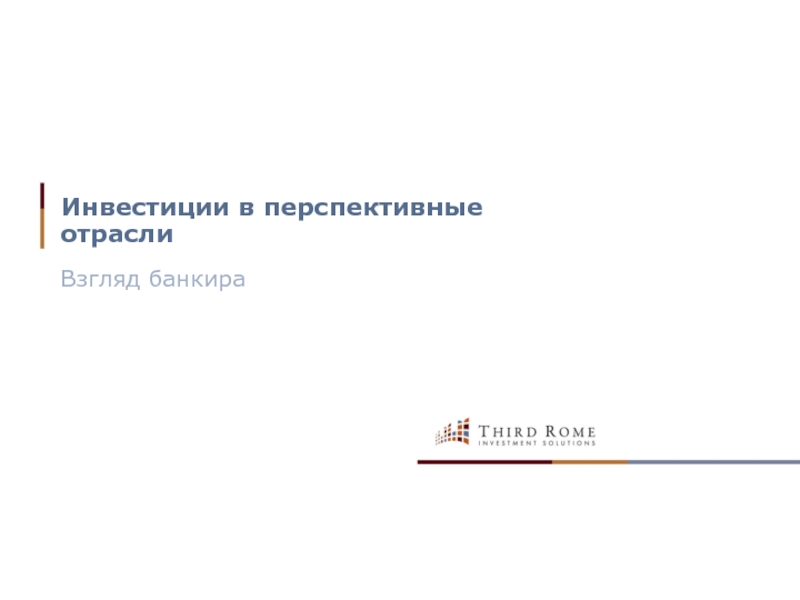- Главная
- Разное
- Дизайн
- Бизнес и предпринимательство
- Аналитика
- Образование
- Развлечения
- Красота и здоровье
- Финансы
- Государство
- Путешествия
- Спорт
- Недвижимость
- Армия
- Графика
- Культурология
- Еда и кулинария
- Лингвистика
- Английский язык
- Астрономия
- Алгебра
- Биология
- География
- Детские презентации
- Информатика
- История
- Литература
- Маркетинг
- Математика
- Медицина
- Менеджмент
- Музыка
- МХК
- Немецкий язык
- ОБЖ
- Обществознание
- Окружающий мир
- Педагогика
- Русский язык
- Технология
- Физика
- Философия
- Химия
- Шаблоны, картинки для презентаций
- Экология
- Экономика
- Юриспруденция
Insurance. Company. Operations презентация
Содержание
- 1. Insurance. Company. Operations
- 2. Agenda Rating and Ratemaking Underwriting Production Claim settlement Reinsurance Investments
- 3. Rating and Ratemaking Ratemaking refers to the
- 4. Underwriting Underwriting refers to the process of
- 5. Underwriting Important principles of underwriting: The primary
- 6. Underwriting Underwriting starts with the agent in
- 7. Production Production refers to the sales and
- 8. Claim Settlement The objectives of claims settlement
- 9. Claim Settlement The claim process begins with
- 10. Reinsurance Reinsurance is an arrangement by which
- 11. Reinsurance Reinsurance is used to: Increase underwriting
- 12. Types of Reinsurance Agreements There are two
- 13. Methods for Sharing Losses There are two
- 14. Reinsurance Alternatives Some insurers use the capital
- 15. Investments Because premiums are paid in advance,
- 16. Exhibit 6.1 Growth of Life Insurers’ Assets
- 17. Exhibit 6.2 Asset Distribution of Life Insurers 2007
- 18. Exhibit 6.3 Investments, Property/Casualty Insurers, 2007 Investments by Type
- 19. Other Insurance Company Functions The electronic data
Слайд 3Rating and Ratemaking
Ratemaking refers to the pricing of insurance and the
calculation of insurance premiums
A rate is the price per unit of insurance
An exposure unit is the unit of measurement used in insurance pricing
Total premiums charged must be adequate for paying all claims and expenses during the policy period
Rates and premiums are determined by an actuary, using the company’s past loss experience and industry statistics
A rate is the price per unit of insurance
An exposure unit is the unit of measurement used in insurance pricing
Total premiums charged must be adequate for paying all claims and expenses during the policy period
Rates and premiums are determined by an actuary, using the company’s past loss experience and industry statistics
Слайд 4Underwriting
Underwriting refers to the process of selecting, classifying, and pricing applicants
for insurance
A statement of underwriting policy establishes policies that are consistent with the company’s objectives, such as
Acceptable classes of business
Amounts of insurance that can be written
A line underwriter makes daily decisions concerning the acceptance or rejection of business
A statement of underwriting policy establishes policies that are consistent with the company’s objectives, such as
Acceptable classes of business
Amounts of insurance that can be written
A line underwriter makes daily decisions concerning the acceptance or rejection of business
Слайд 5Underwriting
Important principles of underwriting:
The primary objective of underwriting is to attain
an underwriting profit
The second principle is to select prospective insureds according to the company’s underwriting standards
The purpose of underwriting standards is to reduce adverse selection against the insurer
Adverse selection is the tendency of people with a higher-than-average chance of loss to seek insurance at standard rates. If not controlled by underwriting, this will result in higher-than-expected loss levels.
Underwriting should also maintain equity among the policyholders
One group of policyholders should not unduly subsidize another group
The second principle is to select prospective insureds according to the company’s underwriting standards
The purpose of underwriting standards is to reduce adverse selection against the insurer
Adverse selection is the tendency of people with a higher-than-average chance of loss to seek insurance at standard rates. If not controlled by underwriting, this will result in higher-than-expected loss levels.
Underwriting should also maintain equity among the policyholders
One group of policyholders should not unduly subsidize another group
Слайд 6Underwriting
Underwriting starts with the agent in the field
Information for underwriting comes
from:
The application
The agent’s report
An inspection report
Physical inspection
A physical examination and attending physician’s report
MIB report
After reviewing the information, the underwriter can:
Accept the application
Accept the application subject to restrictions or modifications
Reject the application
The application
The agent’s report
An inspection report
Physical inspection
A physical examination and attending physician’s report
MIB report
After reviewing the information, the underwriter can:
Accept the application
Accept the application subject to restrictions or modifications
Reject the application
Слайд 7Production
Production refers to the sales and marketing activities of insurers
Agents are
often referred to as producers
Life insurers have an agency or sales department
Property and liability insurers have marketing departments
An agent should be a competent professional with a high degree of technical knowledge in a particular area of insurance and who also places the needs of his or her clients first
Life insurers have an agency or sales department
Property and liability insurers have marketing departments
An agent should be a competent professional with a high degree of technical knowledge in a particular area of insurance and who also places the needs of his or her clients first
Слайд 8Claim Settlement
The objectives of claims settlement include:
Verification of a covered loss
Fair
and prompt payment of claims
Personal assistance to the insured
Some laws prohibit unfair claims practices, such as:
Refusing to pay claims without conducting a reasonable investigation
Not attempting to provide prompt, fair, and equitable settlements
Offering lower settlements to compel insureds to institute lawsuits to recover amounts due
Personal assistance to the insured
Some laws prohibit unfair claims practices, such as:
Refusing to pay claims without conducting a reasonable investigation
Not attempting to provide prompt, fair, and equitable settlements
Offering lower settlements to compel insureds to institute lawsuits to recover amounts due
Слайд 9Claim Settlement
The claim process begins with a notice of loss
Next, the
claim is investigated
A claims adjustor determines if a covered loss has occurred and the amount of the loss
The adjustor may require a proof of loss before the claim is paid
The adjustor decides if the claim should be paid or denied
Policy provisions address how disputes may be resolved
A claims adjustor determines if a covered loss has occurred and the amount of the loss
The adjustor may require a proof of loss before the claim is paid
The adjustor decides if the claim should be paid or denied
Policy provisions address how disputes may be resolved
Слайд 10Reinsurance
Reinsurance is an arrangement by which the primary insurer that initially
writes the insurance transfers to another insurer part or all of the potential losses associated with such insurance
The primary insurer is the ceding company
The insurer that accepts the insurance from the ceding company is the reinsurer
The retention limit is the amount of insurance retained by the ceding company
The amount of insurance ceded to the reinsurer is known as a cession
The primary insurer is the ceding company
The insurer that accepts the insurance from the ceding company is the reinsurer
The retention limit is the amount of insurance retained by the ceding company
The amount of insurance ceded to the reinsurer is known as a cession
Слайд 11Reinsurance
Reinsurance is used to:
Increase underwriting capacity
Stabilize profits
Reduce the unearned premium reserve
The
unearned premium reserve represents the unearned portion of gross premiums on all outstanding policies at the time of valuation
Provide protection against a catastrophic loss
Retire from business or from a line of insurance or territory
Obtain underwriting advice on a line for which the insurer has little experience
Provide protection against a catastrophic loss
Retire from business or from a line of insurance or territory
Obtain underwriting advice on a line for which the insurer has little experience
Слайд 12Types of Reinsurance Agreements
There are two principal forms of reinsurance:
Facultative reinsurance
is an optional, case-by-case method that is used when the ceding company receives an application for insurance that exceeds its retention limit
Facultative reinsurance is often used when the primary insurer has an application for a large amount of insurance
Treaty reinsurance means the primary insurer has agreed to cede insurance to the reinsurer, and the reinsurer has agreed to accept the business
All business that falls within the scope of the agreement is automatically reinsured according to the terms of the treaty
Facultative reinsurance is often used when the primary insurer has an application for a large amount of insurance
Treaty reinsurance means the primary insurer has agreed to cede insurance to the reinsurer, and the reinsurer has agreed to accept the business
All business that falls within the scope of the agreement is automatically reinsured according to the terms of the treaty
Слайд 13Methods for Sharing Losses
There are two basic methods for sharing losses:
Under
the Pro rata method, where the ceding company and reinsurer agree to share losses and premiums based on some proportion
Under the Excess method, where the reinsurer pays only when covered losses exceed aa certain level
Under a quota-share treaty, the ceding insurer and the reinsurer agree to share premiums and losses based on some proportion
Under a surplus-share treaty, the reinsurer agrees to accept insurance in excess of the ceding insurer’s retention limit, up to some maximum amount
An excess-of-loss treaty is designed for catastrophic protection
A reinsurance pool is an organization of insurers that underwrites insurance on a joint basis
Under the Excess method, where the reinsurer pays only when covered losses exceed aa certain level
Under a quota-share treaty, the ceding insurer and the reinsurer agree to share premiums and losses based on some proportion
Under a surplus-share treaty, the reinsurer agrees to accept insurance in excess of the ceding insurer’s retention limit, up to some maximum amount
An excess-of-loss treaty is designed for catastrophic protection
A reinsurance pool is an organization of insurers that underwrites insurance on a joint basis
Слайд 14Reinsurance Alternatives
Some insurers use the capital markets as an alternative to
traditional reinsurance
Securitization of risk means that an insurable risk is transferred to the capital markets through the creation of a financial instrument, such as a futures contract
Catastrophe bonds are corporate bonds that permit the issuer of the bond to skip or reduce the interest payments if a catastrophic loss occurs
Catastrophe bonds are growing in importance and are now considered by many to be a standard supplement to traditional reinsurance.
Securitization of risk means that an insurable risk is transferred to the capital markets through the creation of a financial instrument, such as a futures contract
Catastrophe bonds are corporate bonds that permit the issuer of the bond to skip or reduce the interest payments if a catastrophic loss occurs
Catastrophe bonds are growing in importance and are now considered by many to be a standard supplement to traditional reinsurance.
Слайд 15Investments
Because premiums are paid in advance, they can be invested until
needed to pay claims and expenses
Investment income is extremely important in reducing the cost of insurance to policyowners and offsetting unfavorable underwriting experience
Life insurance contracts are long-term; thus, safety of principal is a primary consideration
In contrast to life insurance, property insurance contracts are short-term in nature, and claim payments can vary widely depending on catastrophic losses, inflation, medical costs, etc
Investment income is extremely important in reducing the cost of insurance to policyowners and offsetting unfavorable underwriting experience
Life insurance contracts are long-term; thus, safety of principal is a primary consideration
In contrast to life insurance, property insurance contracts are short-term in nature, and claim payments can vary widely depending on catastrophic losses, inflation, medical costs, etc
Слайд 19Other Insurance Company Functions
The electronic data processing area maintains information on
premiums, claims, loss ratios, investments, and underwriting results
The accounting department prepares financial statements and develops budgets
In the legal department, attorneys are used in advanced underwriting and estate planning
Property and liability insurers provide numerous loss control services
The accounting department prepares financial statements and develops budgets
In the legal department, attorneys are used in advanced underwriting and estate planning
Property and liability insurers provide numerous loss control services

